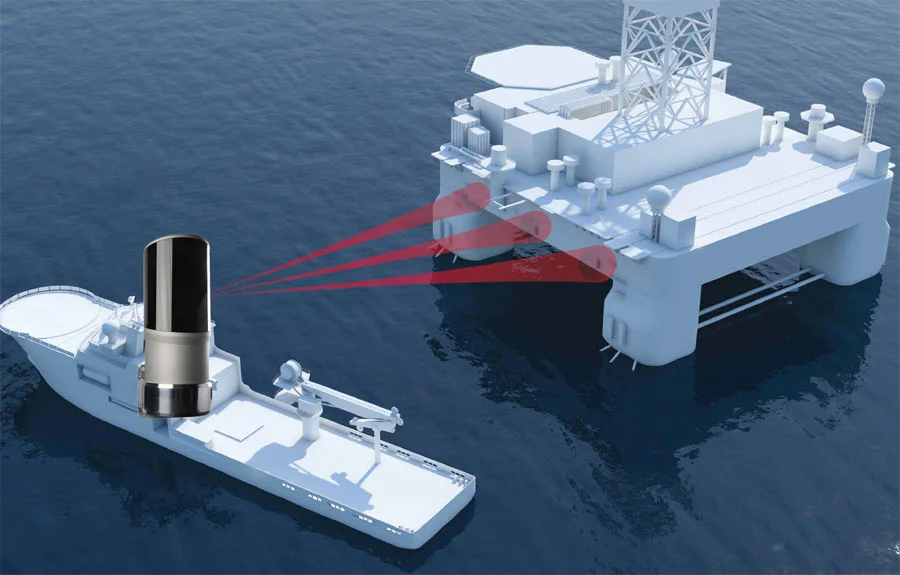
Let’s start with the basics. There are different types of position reference sensors that work on different principles. They all determine the position of the sensor from reference points, usually from actively sent or received signals. Sensors that are dependent on the same signals through the same medium (material, not the spooky kind) have common failure modes and are not independent. So, two DGPSs should only really count as a single reference for the purposes of redundancy. Two HPRs count as one, two laser (Fanbeam, CyScan, SceneScan, SpotTrack) count as one, and two radars (Radius, RadaScan) count as one. Even two taut wires count as one reference if a net drifts across them, a chain, cable or pipe is pulled across them, or if they are both dragged by the vessel.
So, each set of one type of sensor only counts as a single sensor for the purposes of redundancy. 4 DGPSs = 1 DGPS with redundant hardware and power. There are things that can be done to partially improve separation, such as using different satellites, corrections, and manufacturers, but reducing the number of satellites and corrections to provide separation reduces the fault rejection, accuracy, and reliability of each DGPS. Sadly, this was recommended for years, but the industry eventually learned. Despite all the additional frequencies and satellites and corrections, they still have common failure modes, whether it is electro-magnetic interference in the atmosphere, or a passing shrimp boat with a bad satellite dish. Other position references have similar limits to their operation and optimization, so real independence and redundancy requires at least two different types of position sensors.
But I said “three.” Two is good enough for a simple failure where one set of sensors stops working and the system continues using the remaining healthy sensors. But sensors don’t just fail by not working, they also fail by lying. When you have two sets of sensors disagreeing, sometimes the faulty set is obviously wrong, but sometimes you can only tell by comparing with an independent set of sensors. This is basic - if your oven and microwave clocks disagree and one says midnight during the day then that is solvable, but when it isn’t you need to check your phone, watch, or computer. When two people disagree about something, a reliable independent witness can make the difference. In the same way, while disagreeing sensors can sometimes be caught, sometimes only a third independent sensor can identify the faulty set of sensors.
But class rules only require three position references, only one of which needs to be of a different kind, and which may only exist to achieve classification and never be used. It’s not redundant. Why do we put up with it?
Mostly, it is because we have no choice. There are only a handful of good absolute and relative position reference systems. Relative sensors that can be used between moving vessels aren’t bad, as there are several options (laser, radar, DARPS, gangway, relative HPR (beacon on ROV, riser, pontoon, etc.)), but fixed systems only include DGPS, seabed HPR, and taut wires. Taut wires can only be used in shallow water, so that leaves just two deep water position references and one of them requires someone to install beacons far underwater. The cost and delay of installing the beacons means that some operations are performed with only DGPSs. It is hard to require vessels to use three different types of sensors when only one or two are practical.
Even vessels that mostly perform relative positioning need to be careful mixing relative and absolute position references. Everyone has a DGPS, or two, or three, but not everyone is willing to pay for three different types of relative sensors, and it is not required by the rules.
Sometimes, the industrial mission of the vessel provides a poor quality third reference for the DPO’s use. It is poor quality because it is dependent on more than just position and may not be fault tolerant. For example, riser angle can be used to decide between drill ship position references once the difference becomes large enough to register, and changes in pipelay force can be an indication of problems.
Position references are a known redundancy problem, and it normally falls on the DPO to handle it. Many DP control systems aren’t setup or designed to take advantage of three independent sensor types. Ideally, we would require three independent position references, but many vessels can only use two independent position reference system types, and some are stuck using one. The rules can be tightened for relative positioning, but not for absolute, so the general DP rules have not been changed. Operators need to beware, and vendors need to go inventing, so they can fill a market need.







